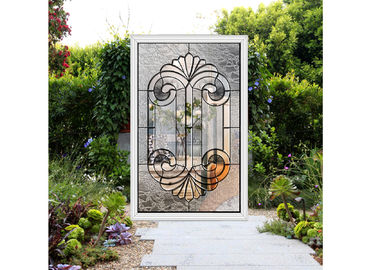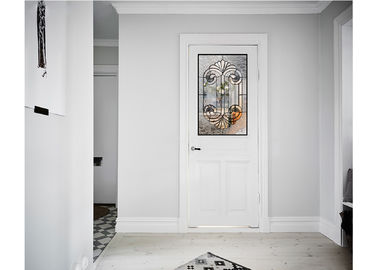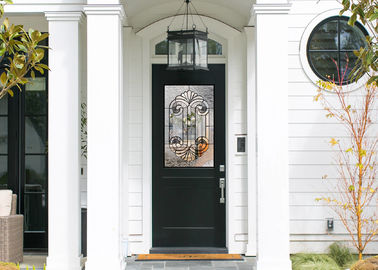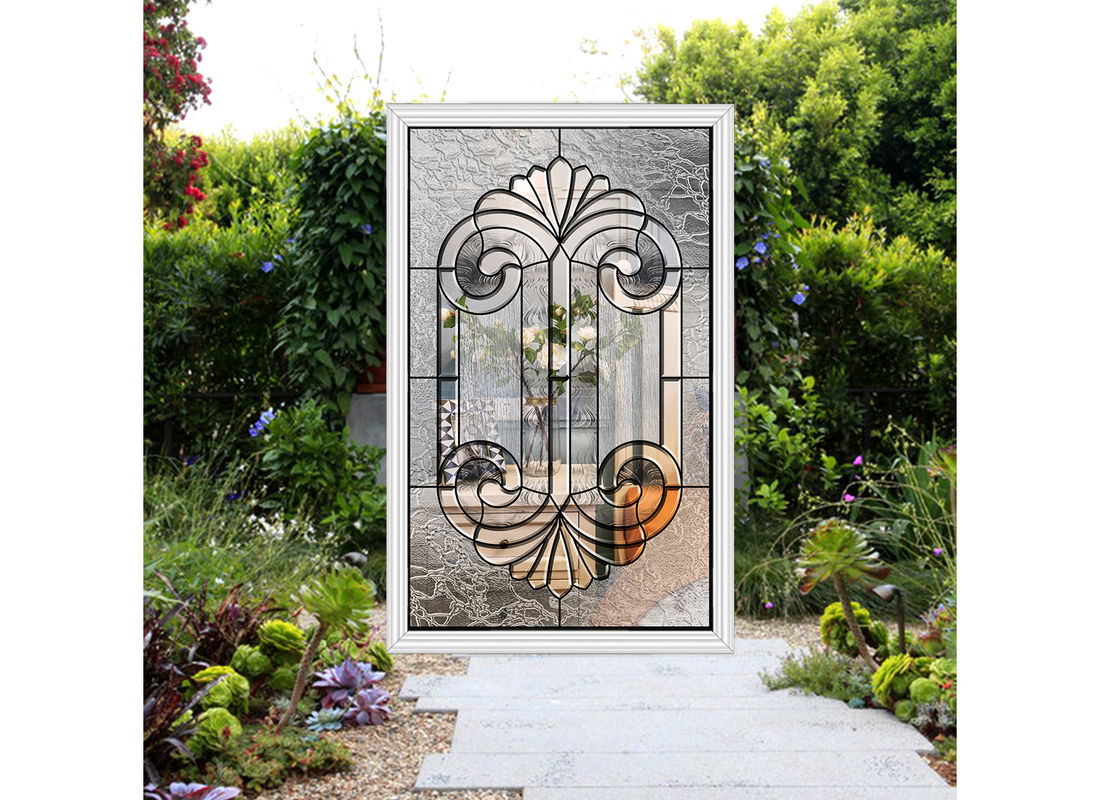Aluminum Window Frames
Aluminum window frames are strong, but lightweight. They are ideal for openings that require customized frames. They can hold large, heavy, or odd-sized panes of glass. Frames made exclusively from aluminum, however, are not as energy-efficient as other frames. Aluminum frames often account for large amounts of heat loss, and contribute to condensation around the edge of the pane and on the frame. New aluminum frames usually have thermal breaks, which are insulating plastic strips between the inside and the outside of the frame and sash. Thermal breaks improve the R-value of aluminum windows, although the most basic aluminum window with thermal breaks still may not be the best choice for cold climates.
In some of the more advanced aluminum windows, the thermal break is combined with foam insulation to create a super energy-efficient frame. One window manufacturer produces an aluminum frame with foam insulation that has a frame R-value of about R-5.6. When combined with high-efficiency glazing, the window has an overall R-value of R-6.3.
Because they corrode easily, aluminum window frames may be a poor choice for those who live near the seashore or in heavily polluted areas. You can paint aluminum frames, although they need special coatings to ensure an attractive, long-lasting finish.
Wooden Window Frames
Wood window frames are still the choice of most homeowners and most major window manufacturers. Wooden window frames have a higher R-value than aluminum and may have a more traditional look. Temperature extremes do not effect them, and condensation is less common because the inside of the frame stays relatively warm. Since they are easy to paint, wooden window frames also allow the consumer to change the color of the window. Wooden window frames, however, require considerable maintenance, including periodic painting. If they are not protected from moisture, they can stick, crack, and warp. As the cost of wood increases, manufacturers have begun using veneers over lower grade wood or strandboard cores. While these are not solid wood, the wood fiber determines the performance of the frames if the percentage of resin is less than 5%.
Aluminum-clad and Vinyl-clad Wooden Frames
Vinyl-clad and aluminum-clad wood frames are wood frames covered on the exterior with either vinyl or aluminum. This allows the homeowner to have the higher R-value and traditional look of the wood frame indoors, while avoiding periodic painting outdoors. These window frames, however, may rot if the cladding leaks and moisture reaches the wooden frame.
Wood-Plastic Composites
Several companies produce window frames made from wood scraps, vinyl waste, polyethylene, and other recycled products. They may contain as little as 50% wood fiber. The advantages of composite frames are strength and resistance to moisture. Although made from recycled products themselves, the mixture of materials used to make composites makes them difficult to recycle.
Vinyl Window Frames
Vinyl window frames have become a popular option, especially for consumers who want to replace old window frames or install windows in unconventional openings. Vinyl window frames are primarily made from polyvinyl chloride (PVC), a relatively flexible material that allows them to be easily customized to fit almost any opening. Vinyl window frames are available in a wide range of styles and shapes.
Vinyl window frames offer many advantages because they require little maintenance and mold easily into almost any shape. The thermal performance of vinyl windows depends on the type and quality of the window. At least one manufacturer produces frames filled with foam insulation. Computer calculations and at least one laboratory test suggest that the R-value difference between foam-filled and hollow vinyl windows adds little to the overall window energy performance.
Vinyl frames do not need to be painted because the color is uniform throughout. They do not swell, shrink, peel, or corrode, which make them ideal for homes and businesses near the ocean or in heavy industrial areas. Vinyl window frames are one of the best options for remodeling projects, because the manufacturer fabricates the frames to the specified dimension of the opening. This ensures that the windows will fit tightly in the opening, reducing heat loss and condensation. Dealers can usually install replacement windows in one or two days. Vinyl window frames are also competitively priced.
Because of the nature of the material used, vinyl window frames also have disadvantages. For example, they are not inherently strong or rigid. The flexible qualities of PVC also limit the size of the frame and the weight of the glass used in it. Some vinyl frames are reinforced with metal to compensate for these limitations, but this lowers their R-value. Vinyl window frames can soften, warp, twist, and bow if heat builds up within the frame. Moreover, the color of the window frames may fade over time. One manufacturer offers a new type of vinyl frame that is more resistant to distortion and discoloration from the sun and heat. In hot climates, ordinary vinyl windows are only sold with white frames, to limit solar heat absorption. Because this new material tolerates higher temperatures, this will allow it to be available in more colors for hot climates.
When purchasing vinyl windows, you may also want to consider certain other qualities of window frames. For example, window frames with corners that are welded together with heat (often referred to as fusion- or heat-welded) are usually more durable than frames with plastic corner gussets or corner keys, or those that are glued together (solvent-welded). You can paint vinyl window frames with special paints, but you should make sure that painting the vinyl does not violate the frame manufacturer's warranty. You should also beware of dealers who claim that they have windows in stock and can alter the opening to accommodate the new window. The window frame may not fit properly, and the added cost for labor may exceed the cost of a customized window frame.
Fiberglass Window Frames
Fiberglass window frames are a relatively new type of frame made of fiberglass composite material. Some of these window frames are hollow; others are filled with fiberglass insulation. Most are prefinished with a white or brown polyurethane coating. These window frames are manufactured using a process called "pultrusion." Glass matting and continuous glass strands are pulled through a tub filled with resin. The window frames are then formed in a preformer and pulled into a heated die. A chemical reaction hardens the material.
Fiberglass is an excellent insulating material. In addition, fiberglass window frames do not warp, shrink, swell, rot, or corrode. They do not soften and degrade under the thermal conditions that most windows are exposed to, and they require virtually no maintenance. Fiberglass window frames are also relatively strong and durable, and can hold a large expanse of glass. You can specify almost any color you desire. You can also paint them.
Although fiberglass may be the window frame of the future, there are a few disadvantages. They may not be widely available. Currently, only a few companies manufacture them, and the long-term performance is still unknown. Fiberglass window frames also cost more than the other types of window frames. Dark-colored fiberglass frames can also fade. Consumers should not use harsh or abrasive cleaning agents on the sash and frame, as they can fade, discolor, or physically weaken the material. Also, insulated window coverings, shutters, and other shading devices, as well as direct applications of certain films to the surface of the glazing, may cause thermal stress and adversely effect the thermal performance of the window.
FRAME CONSTRUCTION
Traditional windows are divided into smaller sections (or "lights") by muntins. These are small framelike dividers or grilles. When they truly divide the window, there is a considerable energy penalty caused by the increased edge area. Most manufacturers use removable plastic or wood grilles that clip onto the inside of the sash. Some manufacturers obtain a traditional look, without losing energy, by gluing muntins to both sides of the window.
The insulation value of a double-pane or triple-pane window is primarily a product of the still air space between the panes of glass. Spacers separate the panes at the edges. Until recently, most edge spacers were made of square metal tubing, usually aluminum. Metal edge spacers are easy to manufacture and easily formed to various window shapes. Unfortunately, metal conducts heat extremely well. In a window with metal edge spacers, this means that the edge of the window has little or no insulating value. The temperature of the inside pane of glass in this area will be very close to the temperature of the outside pane. The colder edges can cause heat to escape and condensation to occur along the window edges.
Recently, several manufacturers have introduced edge spacers with increased insulation values. The alternative edge spacers come in a variety of forms. By using reduced metal thickness, a less conductive metal (such as steel), and by changing the geometry of the spacer from a "D" shaped tube to a "U" shaped channel, some manufacturers have been able to get increased energy efficiency from edge spacers without having to retool their production machinery. Other alternatives include using two layers of rubber with a thin piece of metal sandwiched in between for structural rigidity, or using other materials such as foam or fiberglass with no metal at all. One of the most effective new edge spacers uses both approaches. A thin layer (1/8 inch or 0.3175 cm.) of rigid polyurethane foam separates two steel spacers. This type of spacer boosts the overall energy performance of a typical window by 20% over one using a standard aluminum spacer.
Although welded corners provide the most durable, watertight seal, windows with plastic or urethane thermal breaks cannot be welded. They use a mechanical fastener or bracket in conjunction with gaskets and/or sealant Argon gas-filled windows use a dual seal method. Polybutylene is the most common primary seal and prevents gas leakage from between the panes. A secondary seal of silicon holds the spacer in place and protects the primary seal from moisture degradation. Seals can be damaged during transport or installation. They can also degrade from exposure to sunlight, pooled water, or chemicals. Window units are rated A, B, or C according to their performance in an ASTM "aging" test that involves exposure to Ultraviolet (UV) light, moisture, and extreme temperatures. "A" rated windows are the best performers.
SUMMARY
Energy efficiency is an important factor when purchasing windows for your home, or when replacing old windows. Windows with energy-efficient frames can enhance the thermal performance of the opening, and the entire home as well. You should carefully consider the needs for your home, the climate in your area, your budget, the availability of the windows, required maintenance, and the qualities of the window frame. You should also check for durability, quality, warranties, and cost-effectiveness. The purchase of the right window can turn your drafty home into a warm, cozy, energy-efficient one. The installation of windows should be done after careful research and planning.
![]()
![]()






